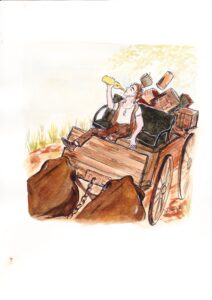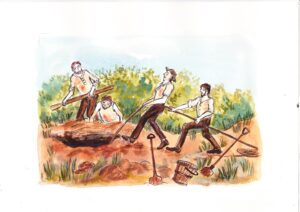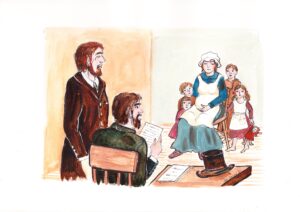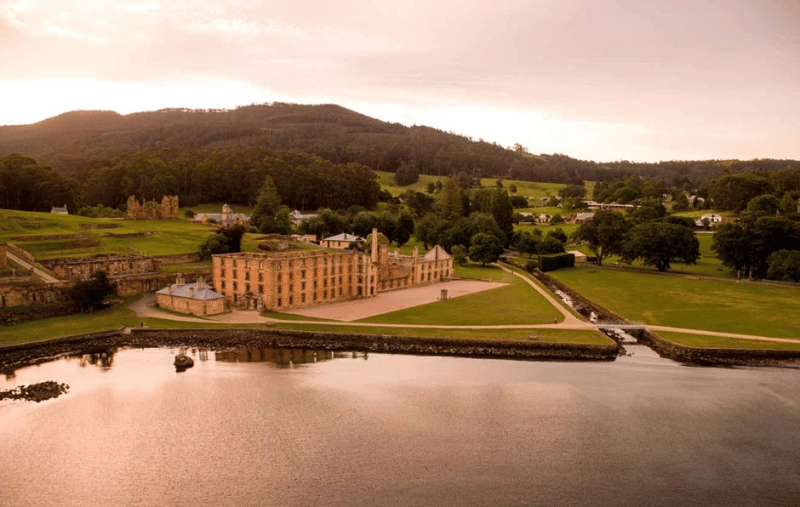Chapter Nine Ann’s Story -The Keeps
Ann’s Story -The Keeps
.
Introduction
William Keep, of Ben Nevis, married Ann Simmons, in Scotland around 1840. Sometime after the birth of their first child, Charles, they decided to come to Van Diemen’s Land. After arriving here in the early 1840s, they settled in Longford.
Nice story but it’s not true. It is a good example of a fabricated family story made up to avoid the indelible stain of convictism and the displacement of the first peoples of the island. A check through readily available records at the time of writing would have revealed William Keep was a capable, rough and ready ex-convict and Ann lived all her childhood in Launceston.
William Keep
William Keep was born around 1809 in Henley on Thames, Oxfordshire, England into the poor underclass. He stood five feet three inches tall, with a florid complexion, grey eyes, and brown hair. Keep had several convictions for housebreaking and poaching, before being transported to Van Diemen’s Land in December 1830. The journey on the convict ship Clyde was relatively uneventful, with all 216 prisoners arriving alive. Keep, however, must have pushed the boundaries as his hull and ship reports were not good.
Keep was initially assigned to Mr. Thomas, who owned property just south of present-day Cressy. Thomas reported Keep for being absent without leave, resulting in a sentence of hard labour. This was not an unusual offence for the time, and it does mean Keep was free to move around. After a short time with Thomas, he was assigned to William Bryant c1832.

Despite his transgressions, Keep managed well for the times, with only three misdemeanours in seven years. Keep aged about 28 was granted a ticket of leave in 1836 as soon as his seven-year sentence was served. Further, his behaviour was such that in November 1835, while still a convict, he was given permission to marry Ann Simmons.
The Keeps (1836 -1846)
In 1835, great, great grandmother Ann, almost 16, found herself entangled in a serious relationship with William, a man nearly twice her age. Through the lens of the 21st century, this might raise eyebrows, but in the 1830’s it was not uncommon. Ann, perhaps eager to escape the disarray of her childhood, saw a new beginning with William.
In March 1836, Ann and William were married. Despite the age difference their relationship seemed to work. From 1836 until 1842 they lived at Winbourne, a property on the southeast side of the confluence of the Nile and South Esk rivers. Their first child Charles was born in October 1836, followed by Eliza in August 1839 and John in June 1842. Ann and her sister Elizabeth remained in close contact, with Ann acting as a witness to Elizabeth’s wedding to George Smith in 1840. I doubt Ann and Elizabeth had much contact with their parents after they married as their parents moved back to Margaret Street, Launceston in the early 1840’s.
The Keeps did not own property so had to find employment. William was prepared to try his hand at anything. As a ploughman, he had little trouble finding work. He worked as a labourer, a shepherd, and a contract well digger. The Keeps took part in community events with William entering ploughing competitions. William also frequented the local hotel and on at least two occasions was fined five shillings for being drunk and disorderly. By 1842 then, Ann had three children to look after as well as dealing with a rough and tumble husband who lived mostly within the law.

In 1845, William Keep and Thomas Richards were charged with stealing and slaughtering three sheep owned by Mr. Weston, a neighbour of the Parkers at Cressy. Keep and Richards claimed they found the sheep on common land between the two properties. The court transcript shows the case was dismissed on a technicality, which was fortunate for the Keeps. While this was happening, Ann gave birth to her fourth child Henry. So, life for Ann certainly wasn’t dull. Recalling Ann’s childhood, I suspect she took it all in her stride and to be fair to William, while a rough diamond, he appears to have treated Ann well.

How Ann aged just 26, a mother of four young children and pregnant with her fifth coped is difficult to determine but I suspect better than we might think. By now her parents were quite old for the time and had shifted back to Margaret Street, Launceston so I doubt they were of much help. Further, I doubt they could have been much help as their lives were still in disarray. Catherine continued to struggle with alcoholism without the moderating influence of her daughters and was arrested several times for drunkenness and fighting in the streets.
I am sure Elizabeth provided some comfort to Ann but by now she also had her own children to look after. Ann stayed in the house on the Wallace property and continued as a tenant farmer. But just six months later, now near term with child number five, the Cornwell Chronicle reports another challenge Ann had to face.
Destructive Fire at Longford. On Sunday morning at about one o’clock, a stack of wheat, containing about for hundred bushels belonging to Mrs Keep, near Longford, was discovered to be on fire and was wholly consumed. Another stack which stood near it, was saved. It is strongly suspected it was the work of an incendiary; the Police are supposed to have some clue that is likely to lead to a discovery. Mrs Keep lost her husband some few months back – he with two others having been suffocated in a well, and although left with four small children has endeavoured to support them through honest industry. This, therefore, will be felt as a most serious loss, and it is hoped that the neighbours and wealthy families in the district will do something towards making it up for her.
The article gives insights into her character. Somehow, she continued to work the property as a tenant farmer as she was known as the owner of 100 bushels of wheat. Special mention was made that even after the tragedy of losing her husband she continued to work in an industrious manner and her community standing was such that wealthy people were encouraged to find ways to assist her. Assistance was forthcoming and she needed it. Her fifth child William was born July 1847. Add to having a newborn and four children under 12 her father, John Simmons, died in November 1847.
I doubt Anne was much assistance to her mother Catherine. Catherine Simmonds ends her life as a lonely alcoholic in a foreign land. Ann’s life, however, takes a turn for the better as she becomes involved with ex-convict John Ewington.
Now recalling great, great grandfather John Ewington was assigned to James Cox of Clarendon who recommended him for an early pardon in January 1847. Maybe Cox and Wallace both wealthy landowners and known for treating their staff well, responded to the call for assistance and suggested to John Ewington that he could be of help to Ann on the Wallace property. Whatever, they met sometime in 1848, developed an intimate relationship and were married in April 1849.
